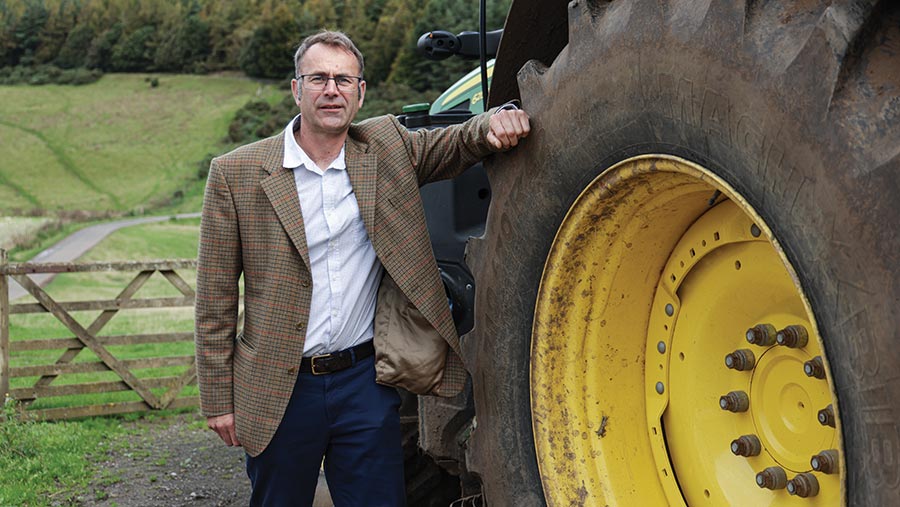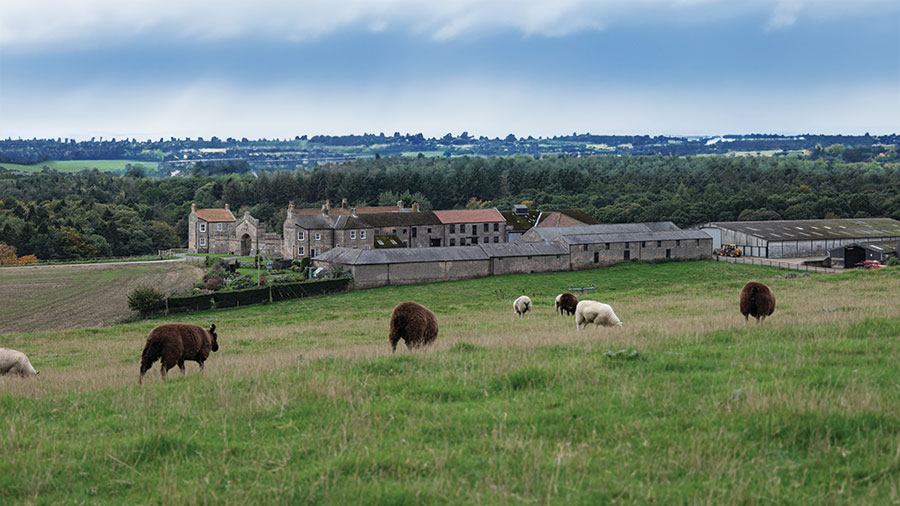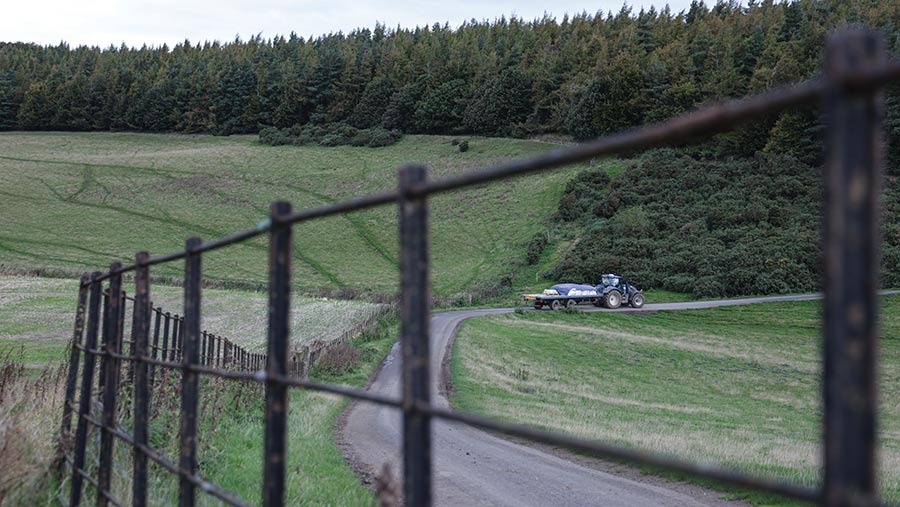How a regen farm is reducing inputs to meet SFI targets
 Phil Vickers © Dave Charnley
Phil Vickers © Dave Charnley The drive to reduce the use of artificial inputs is under way at Raby Farms in County Durham, with the business recognising the economic and environmental benefits of being less reliant on them.
This means fertiliser and pesticide use is under intense scrutiny, with on-farm trials conducted to see where they can be reduced or eliminated, without too much detriment to output or margin.
See also: Tips to keep farms profitable in face of rising inputs
While input plans have to retain some fluidity according to seasonal factors, the direction of travel is clear and the whole farm team is intent on making improvements, says farm manager and Transition Farmer Philip Vickers.
“We want to be as sustainable as possible,” he says. “That’s in line with the ethos of the whole estate, as well as being essential for our future.”
With this in mind, biological alternatives to agrochemicals are being put through their paces to see what they have to offer.
Livestock is also playing a role, with sheep used to graze winter cereals and oilseed rape.

When not grazing pasture, sheep are turned on to winter wheat, encouraging tilling and boosting yields © Dave Charnley
Philip is making brave decisions when it comes to the use of direct drilling too, most of which have rewarded him by preventing moisture loss, reducing fuel use and saving on labour – even if they have given him some sleepless nights.
“We’ve still got a way to go, but we have learned that timeliness matters,” he says.
In addition, nitrogen trials are being carried out in winter wheat, with the aim to optimise nutrition and minimise cost, while keeping crops healthy.
“We know that disease is linked to nitrogen use, as is lodging – which has been an issue for many this year.
“So by getting a better handle on nutrition, we should be able to cut back on our use of fungicides and PGRs [plant growth regulators].”
Grazing oilseed rape
Grazing has reduced the pest and disease threat in most circumstances by removing the parts of the crop that are harbouring pests or carrying disease.
It has to be managed closely to prevent poaching and crop loss.
Initially used as an emergency tool, the sheep proved their worth and helped to revitalise oilseed rape crops that had almost been written off last autumn, says Philip.
“If you overgraze, it’s all over,” he cautions. “So you have to monitor the fields closely and pull them off at the right time.”
As a result of quick action and careful management, just 4% of the original area of the farm’s hybrid oilseed rape was lost in autumn 2022, following a flea beetle infestation.
This year, the unfolding situation is challenging, with a higher percentage of the crop area struggling after pest damage.
In 2022, the crop was drilled at a rate of 55-60 seeds/sq m and established with a companion crop of berseem clover, so there had been some initial expenditure.
“Fortunately, the crop was back in the rows by late December. Due to its shaky start, we spent very little from then on – the crop received some early nitrogen and trace elements, followed by one fungicide.”

Bought-in fertiliser, fuel and labour inputs have been put under intense scrutiny © Dave Charnley
At harvest, the grazed crop yielded slightly less than the farm average of 4.1t/ha, coming in at 3.8t/ha.
“Our income was £100/ha less from it, but it did feed the sheep for a while and it wasn’t being grown on our best land. Considering we were looking at a crop loss, it wasn’t a bad result at all.”
Total nitrogen use on oilseed rape was 170-190kg/ha last year, he adds, whereas historically it had been over 200kg/ha.
Nutrient management
“Our nitrogen plan is a work in progress,” notes Philip. “We cut back considerably on nitrogen in the previous year and our yields increased.
“We lifted the rate slightly in 2023, after a wetter winter, but we are also making better use of organic manures and precision application.”
Nutrient management actions are included in the Sustainable Farming Incentive (SFI) 2023, he acknowledges, which shows that the farm is on the right track with making more efficient use of nutrients.
The fact that SFI 2023 could also reward the business for actions such as not using insecticides and establishing a companion crop is relevant, he admits.
However, the decision to move to a more regenerative approach had already been taken by estate owner Lord Barnard before Defra’s plans were announced.
This has seen a move to direct drilling and the introduction of a diverse rotation, consisting of both winter and spring crops, along with the strategic placement of cover crops.
“We direct-drilled about 90% of the farm in autumn 2022, but the wetter soil conditions this year will see that figure decrease for autumn 2023,” reveals Philip.
“I can’t see the plough ever disappearing completely, and this year has highlighted why, but we have still managed to establish a considerable area by direct drilling.
“Land that had to be ploughed due to ruts left by the combine ploughed very well after two years of direct drilling.
“The healthier and more resilient soils that are being created by our regenerative approach give us wider windows for getting field work done.”
Winter wheat learnings
Nitrogen trials have been conducted in winter wheat, with three different regimes being compared to the farm standard of applying 177kg/ha.
Foliar urea applications – following a base application of 50kg of urea-ammonium nitrate – were done to see what level of yield was possible.
Humates were added to the three 10kg applications, each with 150 litres of water.
Early indications suggest that the highest yields were achieved with the farm standard, but the foliar urea programme did not appear to be far behind and may give a better margin.
The final analysis was still being prepared as Transition went to press.
Sheep were also used to graze winter wheat crops in January, removing as much as half of the canopy.
Just three-and-a-half weeks later, there was a bigger canopy, but there was also more disease – in the form of mildew and rust – on the new growth.
Yields rose by 0.85t/ha where grazing took place, probably as a result of increased tillering, he reports, and septoria levels looked slightly lower to Philip, with the trials company noting a minor decrease.
“We look for wheat varieties with a septoria rating of 6 or above, to make the most of genetic resistance,” he says. “We are also growing blends of four varieties, to see how they perform, on a couple of fields.”
A yellow rust problem in the Group 4 feed variety Gleam wasn’t seen when the variety was included in a four-way blend with Graham, Theodore and Extase.
“We’re trying not to change everything at once and move too quickly,” he continues. “But changing the way that a crop is grown and making better use of diversity should help us to reduce inputs further.”
Trials using biological products, such as sulphur and a seaweed-based elicitor, have demonstrated their potential, but further work is required across different seasons.
“In 2022, which was a dry year with low disease pressure, we saw encouraging results from incorporating some of these products into our disease control programme,” reports Philip. “
There’s potential for them to have a place and reduce our use of fungicides, but we still need to learn more about them.”
The harvest 2023 results are still being analysed. “We were later to harvest it this year and there were some striking visual differences, so it will be interesting to see if they had the same effect.”
Sustainable Farming Incentive 2023 application
An application for a bigger, more ambitious Mid Tier Countryside Stewardship scheme was submitted by Raby Farms ahead of the original August deadline, with the hope of starting it in January 2024.
This will give the business a known level of income for the next five years and ensure that environment and biodiversity targets are met.
Having submitted it, Philip Vicker’s next task is to take a much closer look at SFI 2023 and consider how it can be integrated with existing schemes on the farm, as well as with current cropping.
“At first glance, it seems as though we are already doing some of the actions,” he says.
“If that translates into additional income without compromising what we’re already doing, then we will be pushing ahead with it.”

